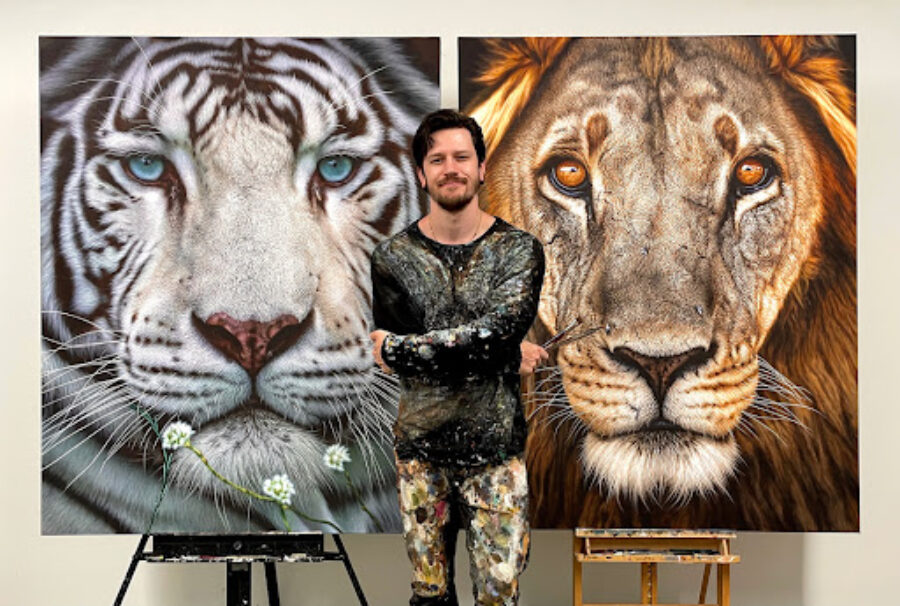In an age saturated with digital imagery, can a painting truly transcend the photograph it mimics? This question lies at the heart of the ongoing debate about the value of hyperrealism in contemporary art. While the digital revolution has redefined visual perception, the art world continues to grapple with the representation of reality. Hyperrealism, a movement that renders paintings and sculptures with a resolution often surpassing that of high-definition photography, might at first glance appear to be merely a mimetic exercise. Yet, in the works of artists like Nick Sider, a deeper dimension is revealed. Sider, a prominent contemporary artist whose practice is firmly rooted in hyperrealism, challenges viewers to look beyond mere replication and engage in a contemplation that extends far beyond verisimilitude. His hyperrealistic paintings stand at a fascinating intersection of technical mastery and thematic resonance, inviting an intellectual engagement with the very nature of representation itself.
The Autodidact’s Ascent: Nick Sider’s Unconventional Path
Nick Sider’s artistic journey is remarkably unconventional, testifying to a deeply rooted passion that forged its own path. As early as five years old, Sider knew he wanted to be a painter, harboring a childlike fascination with art and particularly with drawing big cats. Despite this early inclination, he initially pursued other interests after high school. The decisive turning point came at the age of 25, when Nick Sider quit his job, taught himself to paint, and began to seriously pursue his childhood dream of becoming an artist.
This step of teaching himself to paint was marked by trial and error, yet his early enthusiasm for realistic painting, especially for animal painters, guided his direction. In 2014, Sider moved to New York City, a significant decision for an aspiring artist, and held his first solo exhibition there in 2016. The fact that Nick Sider embarked on this path without formal art education positions him as a kind of “outsider” in the traditional art world. His subsequent success, largely developed outside established gallery networks, illustrates a broader evolution in contemporary art. It shows that traditional institutional recognition is no longer the only path to success. Rather, Sider’s trajectory points to a democratization of art careers, where talent and a unique vision, amplified by new platforms, can bypass conventional structures. This represents a significant cultural shift, making Sider’s biography a case study for evolving artistic careers beyond a personal story.
The Illusion of Life: Sider’s Hyperrealistic Signature
At the core of Nick Sider’s artistic practice is his masterful command of hyperrealism, which he executes with acrylic paints. His stated artistic philosophy is to “bring life to the canvas.” He describes his “favorite moment while painting” as the instant “when a subject on my canvas begins to come alive.” This statement goes far beyond mere replication, revealing a deeper artistic intention.
Nick Sider dedicates himself to meticulous detail, capturing every single whisker, every gaze, and every texture. His paintings seem to “go beyond what a photograph could ever capture.” One of his specific techniques for creating different textures, such as the rough fur of a lion’s mane or the fluffiness of a lamb, lies in the careful dosage of water to his paint. Although Sider uses photographs as source material to achieve this extreme detail, his process transforms the photographic image into a living, breathing subject.
Sider’s specific pursuit of making subjects “come alive” and “go beyond what a photograph could ever capture” directly addresses the philosophical debate within hyperrealism about its interpretive depth. He positions his work not as a copy, but as an enhancement or transcendence of reality, imbuing it with a vitality that photography, despite its precision, may lack. This elevates his practice from mere technical skill to a conceptual quest for “life” on canvas. It is an artistic transformation that turns static images into vibrant presences, thus making a unique contribution to the hyperrealistic movement that goes beyond a purely mimetic exercise.
Echoes of the Wild, Mirrors of Humanity: Themes and Narratives
Nick Sider’s work is thematically multifaceted, ranging from majestic wildlife to poignant human portraits. A central part of his oeuvre includes large-scale paintings of lions and tigers, which he describes as an “ode to his childhood obsession.” The symbolic power of these magnificent creatures is amplified by Sider’s hyperrealistic approach, which makes their presence and wildness palpable on the canvas. His ability to meticulously capture every detail, from individual hairs to the expression in their eyes, gives these animal portraits an almost tangible vibrancy.
In addition to wildlife, Nick Sider also dedicates himself to portraiture, where his skills as a caricature artist proved beneficial in capturing the essence of a person. Here, his hyperrealism unfolds another profound dimension: that of social commentary. Particularly noteworthy are his five-foot portrait of a Syrian refugee girl and his painting of a girl from Zambia, which he created for CURE International. Sider motivated these works with the desire to “draw attention to issues that might otherwise be ignored” and to “direct that attention toward an important cause.”
The transition from depicting the “beauty of nature” to “human suffering” marks a deepening of his artistic intent. These thematic choices lend his hyperrealism a deeper meaning that transcends mere aesthetic appeal, engaging with questions of identity, memory, and pressing global issues. Sider’s ability to leverage the undeniable visual impact of hyperrealism to highlight neglected subjects transforms the often-criticized “reproductive nature” of the genre into a powerful means of “cultural commentary.” This fosters a connection and reflection on identity and human experience, solidifying his position as a significant figure in contemporary art who actively expands the perceived boundaries and purpose of hyperrealism.
Digital Canvas, Global Reach: Reception and Market Dynamics
Nick Sider’s rise to international recognition is inextricably linked to the crucial role of social media. “Viral videos” and platforms like Instagram enabled him to establish a direct connection with a global audience and collectors. Approximately 90% of his sales are attributed to social media, underscoring the transformative power of these channels for art marketing.
Sider’s approach to the art market is remarkably independent. He reports initial difficulties with traditional galleries and a preference for private sales or holding his own exhibitions. He noted that galleries, once the primary players, now have to prove what they can offer artists, as other options exist. This indicates a significant shift in power from traditional institutions to artist-led platforms. His career development is an impressive example of the democratization and decentralization of the contemporary art market.
Although Nick Sider initially pursued the “New York success model” in art, which focused on galleries and major collectors, he quickly realized this was not his dream. His successes developed “very organically,” with inquiries via social media and email allowing him to focus on painting and keep up with demand. His current representation by Galeries Bartoux, a globally operating gallery, represents a fascinating connection between his independent success and the traditional art world. This demonstrates how artists with massive appeal can use digital platforms to build their own markets, forcing traditional galleries to adapt or lose relevance. This development is crucial for the future of art commerce and exhibitions, illuminating aspects of “reception” and “cultural significance” in contemporary art.
Beyond the Lens: Sider’s Place in the Discourse of Contemporary Art
Hyperrealism has always been the subject of intense critical debate. It is often accused of lacking “artistic interpretation” or “emotional depth,” merely replicating a high-resolution photograph. However, Nick Sider’s work challenges these perceived limitations, revealing the immense potential of the genre for profound impact. Sider’s specific thematic choices, from depicting majestic wildlife to poignant human portraits, and his stated goal of “bringing life to the canvas” elevate his hyperrealism beyond mere technical reproduction. His art thus serves as a counter-narrative to the criticism that hyperrealism is purely mechanical.
Sider’s ability to “trick the eye” initially creates a captivating effect, but the true power of his works lies in the emotional and intellectual engagement they evoke. This is particularly evident in his works with social commentary, such as the portraits of refugee children. Here, meticulous detail is not an end in itself, but a vehicle for profound social and emotional engagement, confronting viewers with realities with an almost uncomfortable clarity. Extreme detail can “emphasize important cultural, social, or political themes by offering a unique perspective and by bringing life to emotive scenes and subjects.” Nick Sider embodies precisely this argument.
As a self-taught artist who utilized new media to achieve global recognition, Nick Sider significantly influences how art is consumed and valued in the 21st century. His work bridges traditional painting and contemporary digital image culture. He demonstrates that hyperrealism does not have to be merely a technical spectacle, but can be a powerful tool for empathy and awareness. By leveraging the undeniable visual impact of hyperrealism to highlight ignored subjects, he transforms the often-criticized “reproductive nature” of the genre into a strong means of “cultural commentary.” This fosters a connection and reflection on identity and human experience, positioning Nick Sider as a significant figure in contemporary art who actively expands the perceived boundaries and purpose of hyperrealism, underscoring its capacity for “cultural significance.”
Nick Sider stands as a unique phenomenon in the landscape of contemporary art. His journey from self-taught painter to internationally acclaimed hyperrealist is a testament to the power of unwavering passion and the evolving dynamics of the art market in the digital age. His ability to fill the canvas not only with precise detail but with a palpable vitality challenges traditional notions of realism and representation. Whether in the majestic eyes of a tiger or the touching gaze of a refugee child, Nick Sider succeeds in blurring the line between the painted and the living, making his works more than just images, they are encounters.
Nick Sider’s art invites viewers to look more closely, not only at the canvas but also at the world around them. It challenges our perception of reality and the essence of “life” in art. In an era characterized by the instant availability of digital images, Sider’s hyperrealism proves the enduring relevance and transformative power of painting. His work is a shining example of how traditional art forms, through innovative approaches and the use of new platforms, can remain culturally vital and spark profound dialogues about our shared human experience. The future of realism, it seems, lies in the ability to go beyond the visible and capture the invisible, the soul, the history, the emotion, with a clarity that deceives the eye and touches the heart.









